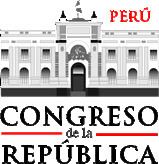Type Unicameral | Seats 130 | |
 | ||
President of Congress Luz Salgado,
Popular Force
Since July 26, 2016 1st Vice President of Congress Rosa Bartra,
Popular Force
Since July 26, 2016 2nd Vice President of Congress Richard Acuña,
Alliance for Progress
Since July 26, 2016 3rd Vice President of Congress Luciana León Romero,
APRA
Since July 29, 2016 | ||
The Congress of the Republic of Peru (Spanish: Congreso de la República) is the unicameral body that assumes legislative power in Peru. The congress consists of 130 members (congresistas), who are elected for five-year periods in office on a proportional representation basis. To be eligible, candidates must be Peruvian citizens, have passed their 25th birthday, and not have had their right to vote suspended. The last congressional election was held on April 10, 2016, concurrently with the presidential election. Since July 26, 2016, the President of Congress is Luz Salgado, of the Popular Force party. Currently, the Peruvian congress congregates at the Palacio Legislativo, which is located in the Historical Center of Lima, across the road from Plaza Simón Bolívar and a few blocks away from Casa de Pizarro.
Contents
- Historical
- Peruvian Congress of 1995 2000
- Peruvian Congress of 2000 2001
- Peruvian Congress of 2001 2006
- Peruvian Congress of 2006 2011
- Peruvian Congress of 2011 2016
- Peruvian Congress of 2016 2021
- List of Presidents of the Senate 1980 1992
- List of Presidents of the Chamber of Deputies 1980 1992
- Presidents of the Congress of the Republic 1995 Present
- References
Historical
The first Peruvian Congress was installed in 1822 as the Constitutional Congress led by Francisco Xavier de Luna Pizarro. In 1829, the government installed a bicameral Congress, made up by a Senate and a Chamber of Deputies. This system was interrupted by a number of times by Constitutional Congresses that promulgated new Constitutions that lasted for a couple of years. The Deputies reunited in the Legislative Palace and the Senators went to the former Saint Inquisition of Lima until 1930, when Augusto B. Leguía was overthrown by Luis Miguel Sánchez Cerro. He installed a Constitutional Congress (1931–1933) that promulgated the Constitution of 1933. By order of the president, the Peruvian Aprista Party members that were in Congress were arrested for there revolutionary doctrines against the government. When Sánchez Cerro was assassinated in 1933 by an APRA member, General Óscar R. Benavides took power and closed Congress until 1939, when Manuel Prado Ugarteche was elected President. During various dictatorships, the Congress was interrupted by coups d'état. In 1968, Juan Velasco Alvarado overthrew president Fernando Belaúnde by a coup d'état, closing again the Congress.
The 1979 Constitution was promulgated on July 12, 1979 by the Constitutional Assembly elected following 10 years of military rule and replaced the suspended 1933 Constitution. It became effective in 1980 with the re-election of deposed President Fernando Belaúnde. It limited the president to a single five-year term and established a bicameral legislature consisting of a 60-member Senate (upper house) and a 180-member Chamber of Deputies (lower house). Members of both chambers were elected for five-year terms, running concurrently with that of the president. Party-list proportional representation was used for both chambers: on a regional basis for the Senate, and using the D'Hondt method for the lower house. Members of both houses had to be Peruvian citizens, with a minimum age of 25 for deputies and 35 for senators. At the beginning of the 1990s, the bicameral congress had a low public approval rating. President Alberto Fujimori did not have the majority in both chambers, the opposition lead the Congress, imposing the power that Fujimori had as President. He made the decision of dissolving Congress by a self-coup to his government in 1992.
Following the self-coup, in which Congress was dissolved, the Democratic Constitutional Congress established a single chamber of 120 members. The CCD promulgated the 1993 Constitution in which gave more power to the President. The new unicameral Congress started working in 1995, dominated by Fujimori's Congressmen that had the majority. The Congress permits a one-year term for a Congressman to become President of Congress.
Peruvian Congress of 1995-2000
On July 27, 1995 a new unicameral Congress was created with the following distribution by political party:
Peruvian Congress of 2000-2001
On July 27, 2000 the Congress of the Republic was established. This Congressional period was marked with various episodes of members of Congress switching their party affiliation. The following distribution marks seats by party at the end of the 2000-2001 term:
Peruvian Congress of 2001-2006
On July 21, 2001 a new Congress of the Peruvian Republic was established the following is a distribution of Congress members by political party affiliation:
Peruvian Congress of 2006-2011
A new Peruvian Congress of the Republic was established in July 2006 with the following distribution:
